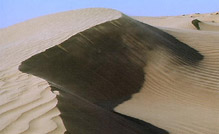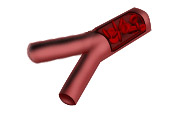
First you’re separated from your military unit, then you find yourselves in the middle of a mine field, and now you’re chased by Nazis into a deep gully between sand dunes. Whew! A close shave, what? But relief turns to despair when the ambulance crew in Ice Cold in Alex find that their truck just doesn’t have the power to get out of the gully.
What to do? The truck engine’s boiling over, the sun’s blazing down and all they want to do is have an ice cold beer in Alexandria. Of course, they have to use the crank shaft of their 1930s truck to winch it backwards up the sand dune! Ingenius! But is it possible?
Hollywood Science busters, Jonathan Hare and Robert Llewellyn, seek out an ageing Morris to prove their point with great success, but will it work with a 4 tonne truck? We set out to find out...
Hand cranking is the old fashioned method for starting a car...
The crank shaft of a car is rotated by the engine at a speed depending on how much throttle is applied, measured in rotations per minute (rpm). A typical value is 3000rpm. Gears in a car change the rpm of the crankshaft to turn the wheels at different rates so that the car can move at varying speeds.
The downside of this is that you have less driving force (torque), which is why it’s easier to accelerate using lower gears. It’s a bit like riding a bike, where it takes less effort to go up a hill in low gear, but you don’t go as far.
The Ice Cold In Alex ambulance is hand cranked, in reverse gear, up a sand dune - a very low gear.
So here are some rough calculations for what the gearing ratio might be. First, let’s assume the wheel is half a metre in diameter - just how far will it travel per turn?
π x 0.5 = 1.26m
For a speed of 8000 metres (8km) per hour the wheel makes:
8000 / 1.26 = 6349 revolutions an hour
Which is
6349 / 60 = 105 revolutions per minute
The gearing ratio is therefore:
3000 / 105 = 29
Twenty nine it is, then.
So... for every turn of the crank shaft the wheel moves 1/29th or, put another way, for every 29 turns of the crank shaft the wheel turns once.

This means for every 29 turns of the engine the truck wheels will complete 1 revolution and hence the truck will move 1.26 metres.
If we assume they take 5 seconds to do one crank how many cranks will this be in one hour? (Assuming of course they don’t take a break.)
3600/5 = 720 turns of the crank.
That sounds like hard sweaty work!
How many turns of the truck's wheels will this be?
720/29 = 24.8 turns of the wheel.
So how far have they traveled in an hour? The number of turns times the distance the wheel moves in one turn:
24.8 x 1.26 ≈ 31 metres
So our truck is travelling at 0.031 km/h - a break neck speed!
To get to the top of the sand dune it looks like they have about 80 metres to travel so this will take them
80/31 = 2.5 hours
... about two and a half hours to do.
Sounds plausible, but would they have the energy for this kind of exercise, it’s darn hot out in the desert?
So let’s see if we can work out how much energy our ambulance crew would expend to get that truck up the slope. One way of doing this is to use trigonometry. What the crew are effectively doing is lifting the truck up vertically from the bottom of the slope to the top. We know that they have a distance on a slope of about 80 metres, and that sand dunes (due to the fact that sand granules slide) have an incline of about 32 degrees. You can measure this angle yourself using a pile of salt and a protractor.
Can we work out how far vertically the truck goes up, and hence how much energy needed to raise it? You bet an ice cold beer we can!
As we all remember from our high school maths:
sin(32)= height of triangle / sloping side of triangle

therefore:
height of triangle = sin(32) x sloping side of triangle
sin(32) x 80 = 42.4metres
The truck is 4 tonnes (4000kg), so how much energy would be required to lift the truck 42.4m?
This is referred to as potential energy -work done against gravity. Potential energy is mgh where m is the mass (in our case 4000kg), g is gravity (10ms-2) and h is the height (42.4m). Energy is given in Joules or calories.
Energy = 4000 x 10 x 42.4= 1,696,000J
One calorie is the same amount of energy as 4.2 Joules.
In calories 1,696,000 / 4.2 = 403,810 calories.
In the film there are 3 people to crank the truck, they take it in turns, so each chap will expend
403810 / 3 = 134 kilocalories.
A man’s daily use of energy is 3,000 kilocalories (Three million calories), which suggests that they would be able to do it.
We haven’t allowed for the amount of friction from the sand, and the internal friction within the mechanics of the truck, which would be large. Also can the crew provide the torque to move the ambulance? Since each turn of the crank effectively starts from a stationary point, moving the truck would be very very difficult.
So in fact the amount of energy required would be greater.
The desert sun is very very hot and the crew need to look out for dehydration, sunstroke and heat exhaustion.
These are the main killers in the desert (except of course for the Nazi troops and the minefield).
Excercise increases the blood flow to the skin, taking the hot blood from deep inside the body, to the surface, where it cools, preventing overheating.
When you excercise in the heat, however, a competition for blood occurs between the exercising muscles (which need blood for the oxygen and for removal of waste) and the skin, as the body tries to cool down.
The result of this is that in hotter temperatures you are unable to exercise for as long as you would be able to in cooler temperatures, as the muscles become starved of oxygen, and waste such as lactic acid builds up in the tissues. In the heat our blood also becomes thicker, as moisture is lost through the sweat glands.

As the blood gets thicker, the flow through the blood vessels becomes more turbulent, and this may activate the clotting system. Small clots can form, blocking blood vessels and leading to heart attacks and strokes.
So, what our ambulance crew needs to do is to drink lots of water. Water makes up 50% to 60% of our body weight and about 80% of muscle weight. Water replaces the 2 to 3% lost due to sweating, and also helps the body cope with the heat by maintaining a constant temperature.
Sweating during exercise does make the body lose water and electrolytes, but the effects are not significant when the exercise lasts for less than 4 hours. The body reacts to the heat by releasing less salt as we sweat.
So if our crew can get the ambulance up the slope in under four hours, they should be fine.
Other nasty complications from exercising in the desert could be heat exhaustion, which results in dizziness, vomiting, racing pulse and breathing. A more serious syndrome is heat stroke, which affects the actual temperature control in the body. So our ambulance crew had better keep their hats on!
Hollywood Science rating: 8/10
Rate and Review
Rate this video
Review this video
Log into OpenLearn to leave reviews and join in the conversation.
Video reviews